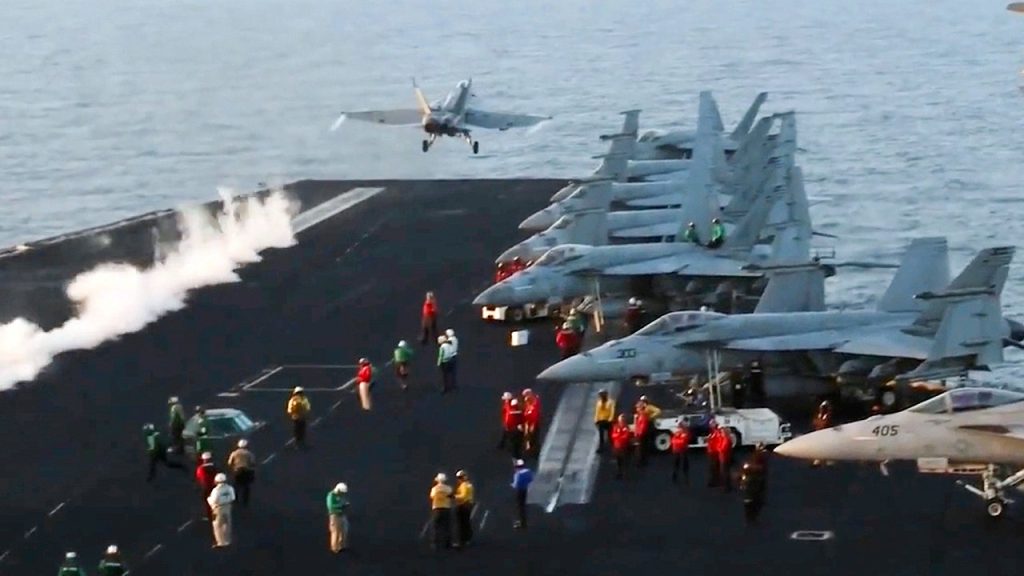On Tuesday, two U.S. Navy pilots were forced to eject from their F/A-18F Super Hornet fighter jet during a landing attempt on the USS Harry S. Truman aircraft carrier in the Red Sea. This incident marks the second loss of an aircraft from the carrier within a week, raising concerns about operational safety. The pilots were recovered and reported only minor injuries, but the aircraft itself was lost in the sea and has not been located.
| Article Subheadings |
|---|
| 1) Background of the USS Harry S. Truman |
| 2) Details of the Incident |
| 3) Immediate Response and Recovery |
| 4) Previous Aircraft Losses |
| 5) Implications for Military Operations |
Background of the USS Harry S. Truman
The USS Harry S. Truman is a Nimitz-class aircraft carrier and a key asset in the U.S. Navy’s global operations. Commissioned in 1998, it has been involved in various military operations, including airstrikes and humanitarian missions. The carrier is equipped with advanced technology to support a fleet of fighter jets and is manned by a dedicated crew responsible for various operational tasks. Recently, the Truman has been deployed in the Red Sea, a strategic area that has seen increased military activity, including operations targeting Iran-backed forces in Yemen.
Details of the Incident
The recent incident occurred when the F/A-18F Super Hornet, part of Strike Fighter Squadron (VFA) 11, was attempting to land on the carrier’s flight deck. Reports indicate that the arresting wire, which is crucial for stopping aircraft during landing, failed, resulting in the fighter jet going overboard. This malfunction highlights significant challenges associated with carrier operations, where precision and timing are essential. The aircraft, valued at approximately $67.4 million, has been lost in the deep waters of the Red Sea.
Immediate Response and Recovery
Following the incident, both pilots successfully ejected from their aircraft and were promptly rescued by the carrier’s search-and-rescue team. Medical evaluations confirmed the aviators sustained only minor injuries, and no personnel on the flight deck were harmed during the incident. The Navy has emphasized the importance of safety protocols and highlighted the immediate actions taken by the crew, who acted quickly to clear the area of the aircraft before it fell overboard.
Previous Aircraft Losses
This incident was not an isolated case, as just over a week earlier, another F/A-18F Super Hornet went overboard from the USS Truman. The previous loss was attributed to an entirely different set of circumstances, as reports indicated it fell during a complex operation on the carrier. These recent incidents prompt an examination of operational procedures and equipment reliability on U.S. Navy aircraft carriers, raising concerns about potential systemic issues that may affect overall mission effectiveness.
Implications for Military Operations
The loss of aircraft jeopardizes both operational capabilities and the safety of personnel. As military engagements evolve, the need for enhanced training and reliable equipment becomes paramount. The USS Harry S. Truman’s strike group continues to maintain full mission capability, but these incidents underscore the complexities involved in naval aviation. Investigations are likely to follow to address the technical failures and recommend preventive measures for future operations, ensuring the carrier strike group remains a deterrent in volatile regions.
| No. | Key Points |
|---|---|
| 1 | Two U.S. Navy pilots ejected from an F/A-18F Super Hornet due to a landing failure. |
| 2 | The incident occurred on the USS Harry S. Truman while it was deployed in the Red Sea. |
| 3 | Both pilots were rescued and reported only minor injuries. |
| 4 | The incident marks the second loss of an aircraft from the carrier in a week. |
| 5 | The Navy is likely to conduct an investigation to address technical failures and improve safety protocols. |
Summary
The recent incident involving the USS Harry S. Truman highlights significant operational challenges faced by the U.S. Navy. With two aircraft losses in quick succession, the need for effective safety protocols and equipment reliability comes to the forefront. As investigations unfold, the military must prioritize enhancing training and preventative measures to safeguard personnel and assets in increasingly complex maritime environments.
Frequently Asked Questions
Question: What happened to the F/A-18F Super Hornet?
The F/A-18F Super Hornet was lost during a landing attempt on the USS Harry S. Truman when an arresting wire failure caused the aircraft to go overboard.
Question: Were the pilots injured in the incident?
Both pilots successfully ejected and reported only minor injuries after being rescued by the carrier’s crew.
Question: What are the implications of this incident for the Navy?
The incidents underscore the need for improved operational safety and reliability in naval aviation, prompting potential reviews of protocols and training.
